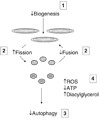Endothelial dysfunction in diabetes mellitus: molecular mechanisms and clinical implications
- PMID: 20186491
- PMCID: PMC2882637
- DOI: 10.1007/s11154-010-9134-4
Endothelial dysfunction in diabetes mellitus: molecular mechanisms and clinical implications
Abstract
Cardiovascular disease is a major complication of diabetes mellitus, and improved strategies for prevention and treatment are needed. Endothelial dysfunction contributes to the pathogenesis and clinical expression of atherosclerosis in diabetes mellitus. This article reviews the evidence linking endothelial dysfunction to human diabetes mellitus and experimental studies that investigated the responsible mechanisms. We then discuss the implications of these studies for current management and for new approaches for the prevention and treatment of cardiovascular disease in patients with diabetes mellitus.
Figures


References
-
- Narayan KM, Boyle JP, Geiss LS, Saaddine JB, Thompson TJ. Impact of recent increase in incidence on future diabetes burden: U.S., 2005–2050. Diabetes Care. 2006;29:2114–2116. - PubMed
-
- Lloyd-Jones D, Adams R, Carnethon M, et al. Heart disease and stroke statistics-2009 update: a report from the American Heart Association Statistics Committee and Stroke Statistics Subcommittee. Circulation. 2009;119:480–486. - PubMed
-
- Eckel RH, Wassef M, Chait A, et al. Prevention conference VI: Diabetes and cardiovascular disease: writing Group II: pathogenesis of atherosclerosis in diabetes. Circulation. 2002;105:e138–e143. - PubMed
-
- Creager MA, Luscher TF, Cosentino F, Beckman JA. Diabetes and vascular disease: pathophysiology, clinical consequences, and medical therapy: Part I. Circulation. 2003;108:1527–1532. - PubMed
-
- Widlansky ME, Gokce N, Keaney JF, Jr, Vita JA. The clinical implications of endothelial dysfunction. J Am Coll Cardiol. 2003;42:1149–1160. - PubMed
Publication types
MeSH terms
Substances
Grants and funding
LinkOut - more resources
Full Text Sources
Medical
Molecular Biology Databases

